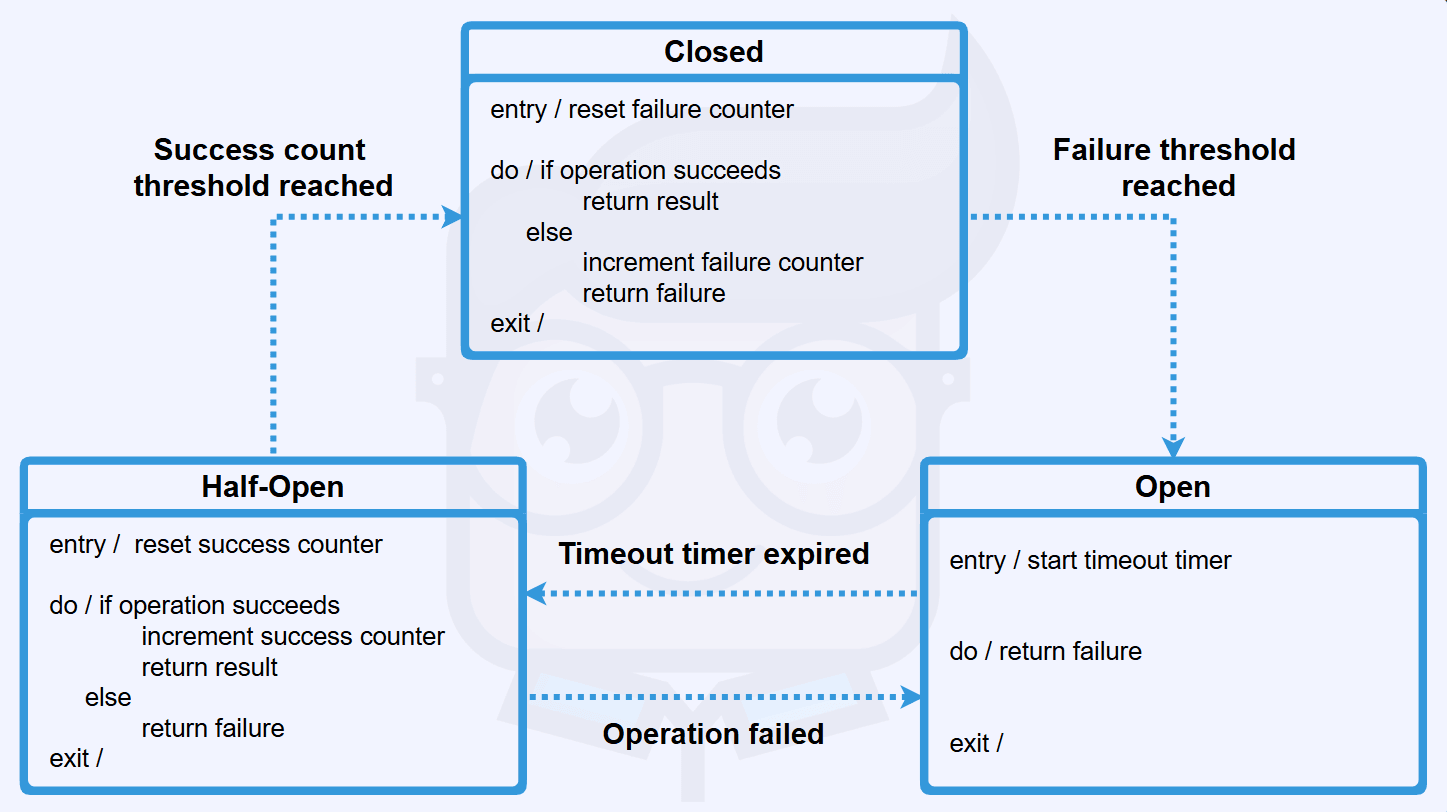
We know how key error handling and fault tolerance are in software development. Modern apps need a reliable safety mechanism. This is to stop failures from getting worse and to keep services running smoothly when problems happen.
The Circuit Breaker Pattern is this safety net. It’s a key part of making sure our apps stay stable. By using this pattern, we make our apps much more resilient. We’ll look into the Circuit Breaker Pattern’s benefits and how to use it well. This will help you create stronger and more dependable apps.
Understanding the Circuit Breaker Pattern
In software development, the Circuit Breaker Pattern is key for making apps resilient and fault-tolerant. As systems get more complex, knowing this pattern is vital for developers. It helps them build strong and dependable software.
What is a Circuit Breaker?
A circuit breaker in software is like the one in your home. which stops the flow of electricity when there’s too much or a fault. In software, it detects when a service is down and stops more requests to it, preventing more failures.
Using a circuit breaker helps make apps more fault-tolerant. It catches when a service might fail and stops more requests until it’s back up.
Importance in Software Development
The Circuit Breaker Pattern is critical in software development. It stops cascading failures in distributed systems. If one service fails, it can cause a chain reaction, potentially crashing the whole app.
By adding circuit breakers, developers boost their apps’ resilience. This makes the app more stable and less prone to errors, improving user experience.
Also, circuit breakers help developers keep an eye on service health. They can spot and fix problems early, preventing bigger issues.
The Circuit Breaker pattern, as detailed in the Azure Architecture Center, is a design strategy aimed at enhancing the resilience and stability of applications, particularly in distributed systems. It prevents an application from repeatedly attempting operations that are likely to fail, thereby avoiding resource exhaustion and cascading failures.
Problem Addressed
In distributed environments, applications often interact with remote services that may experience transient faults such as timeouts, slow responses, or temporary unavailability. While some faults are short-lived, others can persist, leading to repeated failed attempts that consume system resources and potentially cause broader system issues.
Solution Overview
The Circuit Breaker pattern introduces a proxy that monitors the success and failure of operations. Based on predefined thresholds, it determines whether to allow operations to proceed or to short-circuit them to prevent further failures. This mechanism helps maintain system stability by halting operations that are likely to fail and resuming them once the underlying issues are resolved.
How the Circuit Breaker Pattern Works
The Circuit Breaker Pattern uses a complex state management system. It’s designed to catch when a service stops working. This prevents more requests from being sent, stopping a chain of failures.
States of a Circuit Breaker
A Circuit Breaker can be in three states: Closed, Open, and Half-Open.
- In the Closed state, the Circuit Breaker lets requests go through. The system monitors for failures, and if the failure count exceeds a specified threshold within a given time frame, it transitions to the Open state.
- The Open state means the Circuit Breaker has seen too many failures. requests are immediately failed without attempting execution. After a predetermined timeout period, the system transitions to the Half-Open state to test if the underlying issue has been resolved.
- The Half-Open state is a middle step. A limited number of requests are allowed to proceed to see if the service is back up. If these requests succeed, the system transitions back to the Closed state. If failures persist, it reverts to the Open state.
Transitioning Between States
Changing between these states is key for the Circuit Breaker’s success. When in Closed, if too many fail, it goes to Open. In Open, after a wait, it tries Half-Open to see if the service is working.
If the test requests work, it goes back to Closed, showing the service is okay. If they fail, it stays Open, blocking more requests.
The Circuit Breaker’s main job is to spot failures and smoothly change states. This keeps the system stable and can recover from problems well.
Key Considerations
Integration with Retry Pattern: While the Retry pattern attempts to re-execute failed operations, combining it with the Circuit Breaker pattern ensures that retries are halted when failures are persistent, preventing resource wastage.
Resource Protection: By preventing repeated failed operations, the pattern safeguards critical system resources like threads and memory, ensuring they remain available for successful operations.
System Stability: Implementing this pattern helps in isolating faults and preventing them from propagating, thereby maintaining overall system health.
Implementation Tips
Threshold Settings: Carefully configure failure thresholds and timeout durations based on the application’s tolerance for failures and the criticality of operations.
Monitoring and Logging: Implement comprehensive logging to monitor the state transitions and understand the reasons behind failures, aiding in quicker diagnostics and recovery.
Fallback Mechanisms: Consider implementing fallback strategies to provide default responses or alternative processing paths when the circuit is open.
When to Use the Circuit Breaker Pattern
Prevent cascading failures by halting repeated calls to remote services or shared resources that are likely to fail.
Intelligently route traffic based on real-time failure signals, improving multiregion resilience.
Safeguard against slow dependencies, ensuring service-level objectives are maintained despite high-latency components.
Handle intermittent connectivity issues and reduce failure rates in distributed systems.
Benefits of Implementing a Circuit Breaker
The Circuit Breaker pattern is a key safety feature for apps. It stops failures from spreading and makes the app more reliable. This pattern helps developers make their software systems better.
Improved System Stability
Using Circuit Breakers makes systems more stable and catch when a service fails and stop more requests to it. This helps in:
- Stopping failures from spreading and taking down the whole system.
- Lightening the load on failing services, helping them recover.
- Quickly stopping errors from spreading.
Improved system stability is key for keeping users’ trust. It makes sure apps work well even when things get tough.
Enhanced User Experience
Circuit Breakers also make the user experience better. They stop apps from trying to use services that fail. This helps in:
- Shortening wait times and reducing timeouts, making the app more responsive.
- Offering a smoother service breakdown when failures happen.
- Helping the app bounce back faster from failures.
By enhancing the user experience, developers can make users happier and more loyal. This boosts the app’s success.
In summary, using Circuit Breakers is a smart way to make apps stronger and friendlier. They improve stability and user experience. This means developers can catch problems early, keeping the app safe and reliable.
When This Pattern May Not Be Suitable
Accessing local in-memory resources, where the circuit breaker introduces unnecessary overhead.
Used as a replacement for exception handling in application business logic.
Standard retry policies are sufficient and your dependencies are already designed to tolerate transient faults.
Delay caused by circuit reset could be unacceptable in your system’s performance requirements.
In message-driven or event-driven systems that already rely on dead letter queues and built-in retry mechanisms.
Failure handling is managed at the infrastructure level, such as through global load balancers or service meshes with built-in health checks.
Common Use Cases for Circuit Breakers
Circuit breakers are key to keeping systems stable. They are not just ideas; they’re used in real-world software development. They help make systems more fault-tolerant and resilient.
Microservices Architecture
In microservices architecture, many services work together. This makes it complex. Circuit breakers are essential here. They stop failures from spreading when one service is slow or down.
For example, if a payment service is slow, a circuit breaker can stop other services from failing. This keeps the system running smoothly.
APIs and Third-Party Services
APIs and third-party services are common in apps today. They add features like payment and social media. But, they can be slow or down, affecting apps. Circuit breakers isolate these issues, keeping apps running well.
If a weather API is slow, a circuit breaker stops requests to it. This keeps the app working and improves user experience.
Cloud-Based Applications
Cloud apps use many services, making them prone to failures. Circuit breakers manage these failures well. They prevent failures from spreading, keeping apps running even when parts fail.
Netflix is a great example. It uses circuit breakers to handle lots of requests and keep streaming even during outages.
| Use Case | Description | Benefit |
|---|---|---|
| Microservices Architecture | Prevents cascading failures between services | Improved system stability |
| APIs and Third-Party Services | Isolates issues with external services | Enhanced user experience |
| Cloud-Based Applications | Manages partial failures in distributed systems | Increased resilience |
API-Driven Systems
API-driven systems greatly benefit from the Circuit Breaker Pattern, as it helps protect against failures from external or third-party APIs. Instead of allowing repeated failures to overwhelm your application, the pattern ensures that your system degrades gracefully, maintaining stability and avoiding crashes.
Web and Mobile Applications
In web and mobile applications, the pattern plays a crucial role in preserving user experience. When backend services become slow or unresponsive, the Circuit Breaker prevents long wait times and timeouts, ensuring the front-end remains responsive even during backend disruptions.
IoT and Edge Applications
For IoT and edge applications, where connectivity to central systems can be unreliable, the Circuit Breaker Pattern helps manage intermittent communication. It supports fallback strategies such as local caching or offline processing, ensuring continued functionality even when cloud services are temporarily unreachable.
High-traffic E-Commerce Platforms
High-traffic e-commerce platforms also gain significant value from this pattern. During peak traffic periods, like holiday sales events, it helps prevent cascading failures by isolating problematic services. This ensures the reliability of critical user flows like cart management, checkout, and payment processing, even if certain backend components fail.
Financial and Transactional Systems
In financial and transactional systems, stability is non-negotiable. The Circuit Breaker Pattern ensures critical operations—such as payments, fund transfers, and trading—continue to function reliably. It also helps avoid retry storms, which can overwhelm backend services during periods of instability.
Differences Between Circuit Breakers and Other Patterns
When making apps more reliable, it’s key to know the differences between Circuit Breakers and other error-handling methods. How we handle errors greatly affects how stable and user-friendly an app is.
Circuit Breakers, retry logic, and timeouts are all used to manage errors. But they do different things. Let’s look at how Circuit Breakers differ from these other methods to know when to use them best.
Circuit Breakers vs. Retry Logic
Retry logic tries again after a failure, hoping it will work next time. It’s good for short-term errors but can make things worse if the problem is ongoing.
Circuit Breakers, by contrast, stop an app from trying again if it keeps failing. This prevents more stress on the system. The main differences are:
- Retry logic tries to fix the problem by retrying.
- Circuit Breakers stop further attempts after a certain number of failures.
Circuit Breakers vs. Timeouts
Timeouts limit how long an app waits for a response. They prevent endless waits but don’t stop repeated failures.
Circuit Breakers work with timeouts by stopping requests when a service isn’t responding. This makes apps more stable.
| Pattern | Purpose | Benefit |
|---|---|---|
| Circuit Breaker | Prevent repeated failures | Enhances application stability |
| Retry Logic | Overcome transient failures | Improves resilience to temporary issues |
| Timeouts | Limit waiting time for responses | Prevents indefinite waits |
Knowing these differences helps developers pick the best pattern for their needs. This makes apps more stable and better for users.
Best Practices for Implementing Circuit Breakers
Using circuit breakers right is key to making your apps more resilient. By following the best methods, you can make sure your circuit breakers work well. This means they can handle fault tolerance as needed.
Setting Appropriate Thresholds
Choosing the right thresholds is vital for circuit breakers to work well. If the threshold is too low, the breaker might trip too often. This can cause too much downtime.
On the other hand, if the threshold is too high, the breaker might not trip when it should. This can lead to more failures.
To find the right threshold, think about a few things:
- The usual load and performance of your service
- How much your system can handle in terms of failures and delays
- Any past data on failure rates and how long it takes to recover
A good threshold is one that catches failures but doesn’t go off too easily.
| Threshold Type | Description | Example Value |
|---|---|---|
| Failure Threshold | The number of failures needed to trip the circuit breaker | 5 consecutive failures |
| Timeout Threshold | The time to wait before trying again | 30 seconds |
Monitoring and Logging
Good monitoring and logging are key to knowing how your circuit breakers are doing. They help spot problems early.
As Martin Fowler said, “Without proper monitoring, you’re flying blind.”
“You can’t manage what you don’t measure.” – Peter Drucker
This shows how important a strong monitoring system is.
When setting up monitoring and logging for circuit breakers, remember to:
- Watch the circuit breaker’s state (open, closed, half-open)
- Log why the state changed
- Keep track of successful and failed requests
By sticking to these best practices, you can make sure your circuit breakers really help your apps. They will be more resilient and better at handling faults.
Challenges When Using Circuit Breakers
Circuit breakers offer a safety net for your apps, but they come with challenges. They are key to stopping failures in distributed systems. Yet, setting them up can be complex and needs careful handling.
Overhead and Complexity
One big challenge is the overhead and complexity circuit breakers add. They require extra code and setup, making your system more complicated. This can raise costs for development and upkeep.
- Check if circuit breakers are really needed in your system.
- Use libraries and frameworks that make setup easier.
- Have good documentation and monitoring to spot and fix problems fast.
Misconfigured Circuit Breakers
Another big issue is misconfiguring circuit breakers. If set wrong, they might not catch problems or could shut down services too soon. This can upset users.
- Set the right levels for detecting failures.
- Make sure the circuit breaker can spot and handle different errors.
- Keep checking and tweaking circuit breaker settings based on how your system is doing.
Tools and Frameworks Supporting Circuit Breakers
Many frameworks and libraries help make the Circuit Breaker Pattern easier to use. This makes it simpler for developers to add resilience to their software.
Spring Cloud Circuit Breaker
Spring Cloud Circuit Breaker offers a unified API for circuit breakers. It lets developers easily switch between different libraries. This makes managing circuit breakers in cloud-native apps flexible.
Key Features of Spring Cloud Circuit Breaker:
- Consistent API across different circuit breaker libraries
- Easy integration with Spring-based applications
- Support for multiple circuit breaker implementations
Hystrix and Resilience4j
Hystrix helps manage latency and fault tolerance in systems. It isolates access to remote systems and third-party libraries. Resilience4j is a newer library that offers a simple, fault-tolerant solution.
Resilience4j has several benefits, including:
- Lightweight and modular design
- Support for various resilience patterns, including circuit breakers, retry, and bulkhead
- Easy integration with Java 8 and functional programming
Using these frameworks and libraries can make apps more resilient. This ensures a better user experience. The choice between Spring Cloud Circuit Breaker, Hystrix, and Resilience4j depends on the app’s needs and technology stack.
Real-World Examples of Circuit Breaker Success
Companies like Netflix and Amazon have made circuit breakers a key part of their success. They use circuit breakers to make their services more reliable. This pattern is essential for keeping complex systems stable and fault-tolerant.
Netflix: A Pioneer in Circuit Breaker Adoption
Netflix is known for its smart way of handling complex systems. They use circuit breakers to make their apps more stable. Here’s what they’ve gained:
- Reduced cascading failures across services
- Enhanced user experience during peak traffic
- Improved maintainability of their vast microservices ecosystem
Amazon: Leveraging Circuit Breakers for Scalability
Amazon, a tech giant, has also used circuit breakers to boost its services’ fault tolerance. This move has helped Amazon:
- Minimized the impact of service disruptions on customer experience
- Improved the overall resilience of its e-commerce platform
- Enabled more efficient scaling of its services during high-demand periods
These examples show how circuit breakers help in keeping big applications stable. They ensure a smooth experience for users.
The Future of Circuit Breaker Patterns in Development
Software development keeps getting better, and the Circuit Breaker Pattern is key to making apps more reliable. We’re seeing a move towards systems that can handle faults better, thanks to new tech.
Emerging Trends
New trends are changing how Circuit Breakers work. One big change is linking them with advanced monitoring tools. This lets us catch problems before they cause big issues.
The Impact of AI and Machine Learning
AI and machine learning are making Circuit Breakers even better. They can spot problems before they happen. This means we can stop big failures from spreading, making systems more reliable.
The Circuit Breaker Pattern will keep being important in software development. It helps apps stay strong and reliable, even when things go wrong.
Conclusion
The Circuit Breaker pattern is a powerful tool for enhancing the resilience and stability of distributed applications by preventing cascading failures and isolating faults. By understanding when and how to apply it effectively, you can protect your system from unnecessary load and improve overall reliability.
In the next article, we’ll explore how to architect solutions on Microsoft Azure to support this pattern, including native services, implementation strategies, and best practices for real-world scenarios. Stay tuned!






